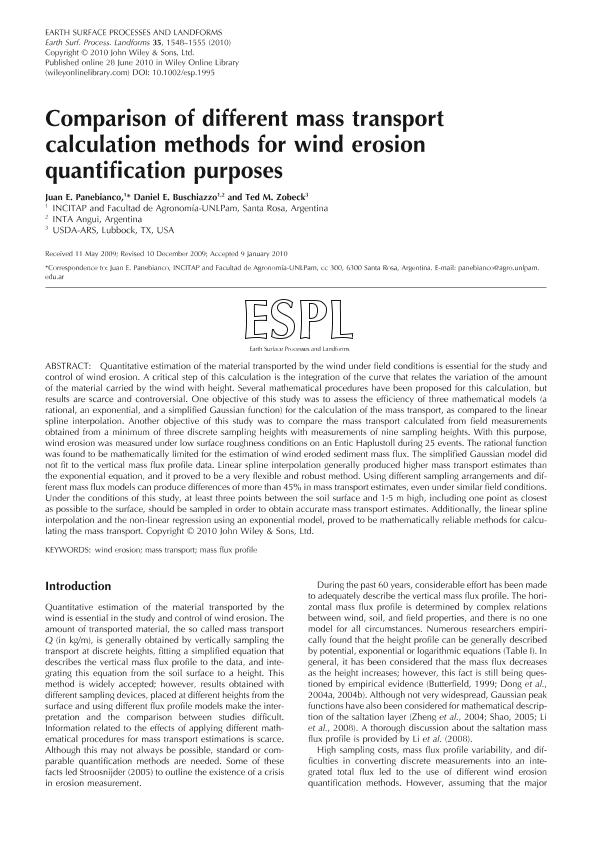Mostrar el registro sencillo del ítem
dc.contributor.author
Panebianco, Juan Esteban

dc.contributor.author
Buschiazzo, Daniel Eduardo

dc.contributor.author
Zobeck, Ted M.
dc.date.available
2018-07-31T19:59:43Z
dc.date.issued
2010-10
dc.identifier.citation
Panebianco, Juan Esteban; Buschiazzo, Daniel Eduardo; Zobeck, Ted M.; Comparison of different mass transport calculation methods for wind erosion quantification purposes; John Wiley & Sons Ltd; Earth Surface Processes And Landforms; 35; 13; 10-2010; 1548-1555
dc.identifier.issn
0197-9337
dc.identifier.uri
http://hdl.handle.net/11336/53661
dc.description.abstract
Quantitative estimation of the material transported by the wind under field conditions is essential for the study and control of wind erosion. A critical step of this calculation is the integration of the curve that relates the variation of the amount of the material carried by the wind with height. Several mathematical procedures have been proposed for this calculation, but results are scarce and controversial. One objective of this study was to assess the efficiency of three mathematical models (a rational, an exponential, and a simplified Gaussian function) for the calculation of the mass transport, as compared to the linear spline interpolation. Another objective of this study was to compare the mass transport calculated from field measurements obtained from a minimum of three discrete sampling heights with measurements of nine sampling heights. With this purpose, wind erosion was measured under low surface roughness conditions on an Entic Haplustoll during 25 events. The rational function was found to be mathematically limited for the estimation of wind eroded sediment mass flux. The simplified Gaussian model did not fit to the vertical mass flux profile data. Linear spline interpolation generally produced higher mass transport estimates than the exponential equation, and it proved to be a very flexible and robust method. Using different sampling arrangements and different mass flux models can produce differences of more than 45% in mass transport estimates, even under similar field conditions. Under the conditions of this study, at least three points between the soil surface and 1·5 m high, including one point as closest as possible to the surface, should be sampled in order to obtain accurate mass transport estimates. Additionally, the linear spline interpolation and the non-linear regression using an exponential model, proved to be mathematically reliable methods for calculating the mass transport. © 2010 John Wiley & Sons, Ltd.
dc.format
application/pdf
dc.language.iso
eng
dc.publisher
John Wiley & Sons Ltd

dc.rights
info:eu-repo/semantics/openAccess
dc.rights.uri
https://creativecommons.org/licenses/by-nc-sa/2.5/ar/
dc.subject
Mass Flux Profile
dc.subject
Mass Transport
dc.subject
Wind Erosion
dc.subject.classification
Meteorología y Ciencias Atmosféricas

dc.subject.classification
Ciencias de la Tierra y relacionadas con el Medio Ambiente

dc.subject.classification
CIENCIAS NATURALES Y EXACTAS

dc.title
Comparison of different mass transport calculation methods for wind erosion quantification purposes
dc.type
info:eu-repo/semantics/article
dc.type
info:ar-repo/semantics/artículo
dc.type
info:eu-repo/semantics/publishedVersion
dc.date.updated
2018-07-30T15:39:33Z
dc.journal.volume
35
dc.journal.number
13
dc.journal.pagination
1548-1555
dc.journal.pais
Reino Unido

dc.journal.ciudad
Londres
dc.description.fil
Fil: Panebianco, Juan Esteban. Consejo Nacional de Investigaciones Científicas y Técnicas. Instituto de Ciencias de la Tierra y Ambientales de La Pampa. Universidad Nacional de La Pampa. Facultad de Ciencias Exactas y Naturales. Instituto de Ciencias de la Tierra y Ambientales de La Pampa; Argentina. Universidad Nacional de La Pampa. Facultad de Agronomía; Argentina
dc.description.fil
Fil: Buschiazzo, Daniel Eduardo. Consejo Nacional de Investigaciones Científicas y Técnicas. Instituto de Ciencias de la Tierra y Ambientales de La Pampa. Universidad Nacional de La Pampa. Facultad de Ciencias Exactas y Naturales. Instituto de Ciencias de la Tierra y Ambientales de La Pampa; Argentina. Universidad Nacional de La Pampa. Facultad de Agronomía; Argentina. Instituto Nacional de Tecnología Agropecuaria; Argentina
dc.description.fil
Fil: Zobeck, Ted M.. USDA‐ARS; Estados Unidos
dc.journal.title
Earth Surface Processes And Landforms

dc.relation.alternativeid
info:eu-repo/semantics/altIdentifier/doi/https://dx.doi.org/10.1002/esp.1995
dc.relation.alternativeid
info:eu-repo/semantics/altIdentifier/url/https://onlinelibrary.wiley.com/doi/abs/10.1002/esp.1995
Archivos asociados
